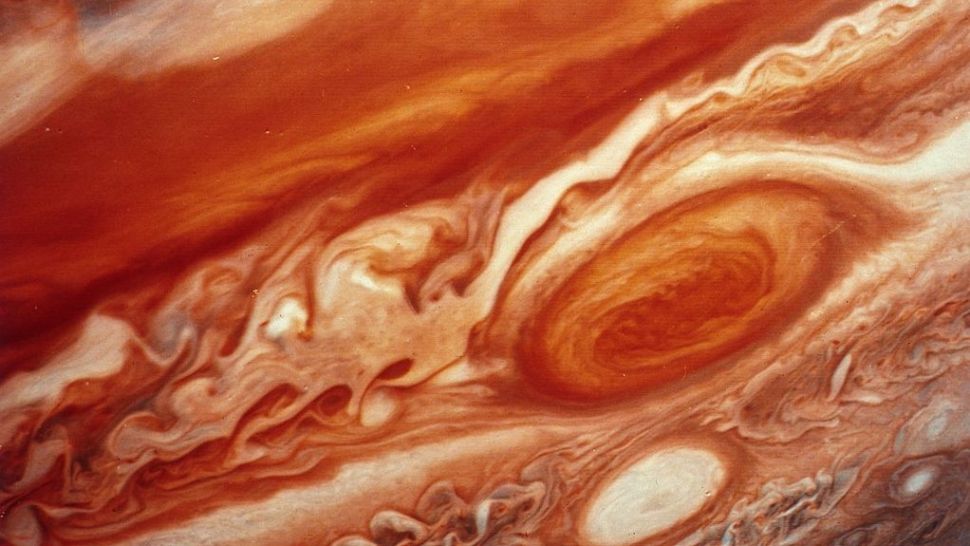The weather in the solar system is unlike anything on Earth. If there is a storm there, it is bigger than all of ours.
Jupiter's Great Red Spot: an Earth-sized hurricane
This legendary storm has been raging on Jupiter for centuriesbut it may end someday. Its size is about 16,000 km across - about 1.3 times the width of the Earth. While recent discoveries suggest that the storm is decreasing, it could absorb other hurricanes and grow stronger.

Jupiter's Great Red Spot is not the only cataclysm on the gas giant: its north and south poles have strange groups of cyclones arranged in a circle.
Lightning on Saturn: 10,000 times more powerful than earthly
Surprisingly, thanks to the spacecraftNASA Cassini, scientists on Earth not only saw lightning on Saturn, but also heard it. The devices of the apparatus have repeatedly recorded abrupt noise in the radio range, which occurred during raging thunderstorms. At the same time, lightning strikes on Saturn are 10,000 times more powerful than those that we see here on Earth.

Radio and visible datarange, indicate that Saturnian lightning flashes as brightly as the most powerful discharges in the earth's atmosphere. Interestingly, the storms there are as powerful, or even more powerful, than on Earth. However, they occur on Saturn much less often. Scientists have never recorded more than one storm at a time, although they have surveyed the entire planet. True, they last for several months.
Solar "outbursts of rage"
The sun is not only the source of life on Earth, itcan and do damage to our planet. In 1859, a powerful solar flare, named after astronomer Richard Carrington, caused massive disruptions to global telegraph communications. This event also caused an incredible aurora - it was visible even in the south, all the way to the Caribbean Sea.

In 1989, a solar flare destroyed the linetransmission of electricity from the Hydro Québec power plant, causing a power outage. As a result, 6 million people were left without electricity for nine hours.
Some experts even link the activityour star and the death of the Titanic. A solar storm could have disrupted the ship's navigation and communications systems and seriously hampered rescue efforts, new research shows.
A storm on Venus that travels faster than the planet
There is a large vortex at the south pole of Venusthe size of Europe. It has existed for a long time and is the result of atmospheric anomalies on the planet. The fact is that, according to the European Space Agency, the atmosphere on Venus moves faster than the planet, reaching speeds of up to 400 km / h - 60 times faster than the rotation of the planet itself.

The wind on Neptune that is faster than the speed of sound
Neptune has the fastest winds inSolar system - they can reach speeds of over 2,100 km / h. This is 1.6 times the speed of sound. These winds also lead to violent storms such as the famous Great Dark Spot observed by Voyager 2 in 1989.

In addition to high speed, they have another interesting feature. Unlike hurricanes on Earth, some of them rotate clockwise, following the direction of the planet's rotation.
Martian dust storms: tornadoes visible from space
In 2018, a huge dust storm swept throughthe surface of Mars, hiding most of its surface from view. These storms, which are rare, but do occur on Earth, regularly happen on Mars, every few years. But in 2018, he was especially strong. They appear due to the fact that the Sun heats the atmosphere of the planet, raising dust from the surface.

Dust also periodically appear on Mars."Devils" are miniature tornadoes that form and move across its surface. This phenomenon is also typical not only for the Red Planet, but also for the Earth. However, Martian storms are visible from space. In 2012, the Mars Reconnaissance Orbiter spotted a colossal Martian dusty "devil" 800 m high and 30 m wide.
Titan's Methane Rain: Feel Every Drop
The largest moon of Saturn, Titan, is one ofmost mysterious bodies of the solar system, but one of the candidates for colonization in the outer part of the solar system. One of the reasons for the interest in the colonization of the satellite is the presence of hydrocarbons, which are now used by most of the earth's technology. However, before checking in, it is worth considering the difficult weather conditions. Even if you're used to rain, how about methane? On an icy moon, such drops fall very slowly due to low gravity and thick haze. As a result, hypothetically, a person can feel each of them.

Titan's hydrological cycle (where "hydro" refers to methane, rather than water as on Earth) shapes the landscape, creating huge lakes. For example, such as Kraken Mare, more than 300 meters deep.
Where is the best place to live?
Earthlings are increasingly exploring the worlds of the Solarsystems as new habitats. Weather is one factor to consider when making plans for colonization. So far, our planet - with all its shortcomings - is the most comfortable world for life.